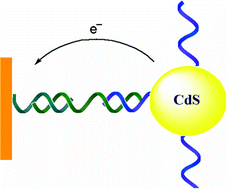CdS nanoparticles linked through a duplex DNA to a Au electrode do not lead to a noticeable photocurrent upon their illumination in the presence of triethanolamine, TEOA, 20 mM, pH = 7.2. The intercalation of doxorubicin into the duplex DNA stimulates, however, the generation of a photocurrent. This is attributed to the trapping of photoexcited conduction-band electrons by the intercalator units that facilitates, by a hopping mechanism, the electron transport to the electrode. The oxidation of TEOA by valence band holes allows the formation of a steady state photocurrent. This basic phenomenon is used to probe the operation of a DNA-based machine through the assembly of CdS nanoparticles on a Au electrode. The machine includes a nucleic acid “track”, (1), that binds a primer, (2), through hybridization to a predefined domain. In the presence of polymerase, the nucleotide mixture, dNTPs, and the nicking enzyme, the autonomous replication, nicking and displacement of the “waste product”, (3), are activated. The “waste product” bridges the (4)-functionalized CdS nanoparticles and the nucleic acid (5)-functionalized Au electrode, resulting in the assembly of the nanoparticles on the electrode. The intercalation of doxorubicin into the DNA–CdS nanostructures results in the generation of photocurrents upon illumination in the presence of TEOA, pH = 7.2. The photocurrents are controlled by the time intervals used to operate the DNA machine.


 Please wait while we load your content...
Please wait while we load your content...